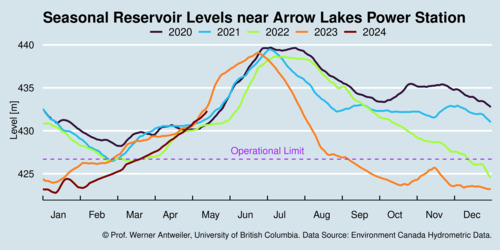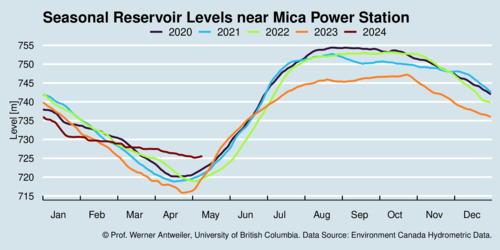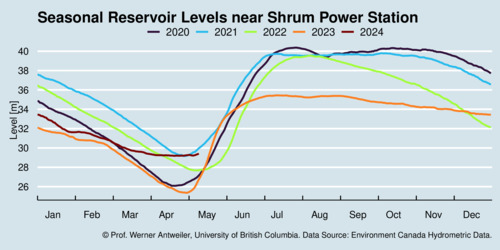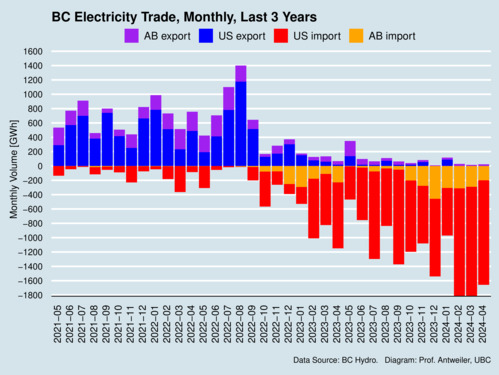The year 2024 is expected to be another drought year in British Columbia. The Canadian Drought Monitor at Agriculture and Agri-Food Canada shows that some areas in BC are again suffering from extreme and exceptional drought. At the end of April, 89% of the Pacific Region was classified as "abnormally dry". Rivers are seen receding. And BC's May 2024 Snow Survey and Water Supply Bulletin reported that the provincial snowpack is averaging only 66% of the normal level. What will continued drought conditions mean for electricity supply in British Columbia, which depends on rain fall and snow fall to replenish reservoirs and power our hydro-electric turbines? The month of May is a good time to look at this question as this month marks the onset of the snowmelt season.
As the CBC reported in March, drought conditions in the West Kootenay reduces water levels in Arrow Lake reservoir so that the Arrow Lake Generating Station [185 MW capacity] had to shut down. The diagram below shows that in 2023 (orange line) the water level dropped below the operational limit (purple dotted line). Fortunately, Arrow Lake is one of the smaller power plants in BC.

click on image for high-resolution PDF version
Climate change poses notable risks to BC's water resources. A 2013 report from BC Hydro investigated Potential impacts of climate change on BC Hydro's Water Resources. Various emission scenarios point to an overall increase in precipitation, although with an earlier snow melt and less snow accumulation. This in turn will shift water flow seasonally. Long-term scenarios and short-term reality are different can and do deviate. Weather conditions have put BC into drought conditions for the third year in a row.
As a result of low reservoir levels, BC Hydro was forced to import a record amount of electricity in 2023. I have discussed this topic in my December 2023 blog BC has become a net electricity importer in 2023, and also in my recent blog British Columbia's evolving electricity trade with the United States. BC Hydro is taking prudent steps to prepare. Below I explain how.
B.C. Hydro's largest dams are along the Columbia River and Peace River. One major reservoir is Kinbasket Lake, created by the Mica Dam, with a capacity of nearly 25 cubic kilometers. The Mica Generating Station has a capacity of 2,816 Megawatts [MW]. Below the Mica dam sits the Revelstoke Reservoir (with just 1.5 cubic kilometers capacity) and the Revelstoke Generating Station with 2,840 MW capacity.
The diagram below shows the water levels in Kinbasket Lake over the last four years and through early May this year. The orange curve shows the water level in 2023, which stands out as clearly below normal. Water levels reach a minimum typically in late April before the lake receives more runoff from the mountains. The year 2024 (dark red curve) started off at a very low level, but has now flattened out remarkably despite insufficient rain fall and snow melt. It is apparent that BC Hydro has been reducing output from the Mica Dam in order to preserve water levels for later in the year, especially during the time when electricity demand peaks during the heating season.

click on image for high-resolution PDF version
‘Electricity imports in the spring help prepare for peak demand next winter and facilitate seasonal price arbitrage.’
In order to preserve water in this and other reservoirs, BC Hydro needs to import electricity so that output from Mica (and other dams) can be reduced. This makes good business sense. Buying electricity when it is relatively cheap (in the spring) allows BC Hydro (and its trading subsidiary Powerex) to keep the energy stored in the dams and use them in the winter when needed—and even export electricity when it is very profitable in the winter. My last blog has documented the benefits of electricity trade with the United States clearly. Reservoirs essentially work like giant seasonal batteries.
The other major reservoir in British Columbia is Williston Lake with a water volume of 74 cubic kilometers, which is created by the W.A.C. Bennett Dam and which powers the Gordon M. Shrum Generating Station with 2,907 MW capacity. Downriver is the Peace Canyon Dam [694 MW] and the new Site-C dam [1,100 MW], whose own reservoir will start filling up later this year.
The Diagram below shows that Williston Lake had historic low water levels during 2023 (orange curve), and starting in late 2022 (light green curve). Water levels in 2024 (dark red curve) started low but now have leveled off due to conservation measures. In early May, water levels are roughly at pre-drought 2021 levels.

click on image for high-resolution PDF version
As mentioned above, preserving water for the peak-demand season has prompted BC Hydro's increased imports of electricity. New import peaks have been reached in February and March this year, and continued into April. Monthly net imports of 1,800 GWh in February means that nearly 2.6 Gigawatts of generating capacity could be freed up—enough to keep more water in the reservoirs.

click on image for high-resolution PDF version
An important part of the water management strategy is the new reservoir behind Site-C dam, which is expected to be filled starting this summer. This 83-kilometre-long reservoir along the Peace River will be filled with water from Williston reservoir. The surface area of the Site C reservoir is only about five percent of the area covered by the Williston reservoir, and water levels in the reservoir will fluctuate only within a narrow range. Holding back sufficient water in Lake Williston now will also ease the filling-up of the Site C reservoir. The Site C generating station (yet to be named) is expected to start up in early 2025. With expected output of 5,100 GWh/year, the turbines will be utilized on average with just over half of the dam's 1,100 MW nominal capacity.
Even though BC Hydro's electricity trading has limited the financial impact of BC's current drought conditions, the large amount of net imports do come at a cost even with the benefits from seasonal price arbitrage. Hydro dams are mostly fixed costs; their operating costs are a tiny fraction of their construction cost. Imported electricity is paid for by the Megwatthour. The current trading strategy is meant to protect against costly scenarios in the winter when we do not want to depend on imported electricity, and ideally profit from exporting electricity profitably. Yet, the trading does not mean we get a free lunch. BC Hydro will have reduced income from electricity trade, and possibly even net expenses. I fully expect that there will be no room for another B.C. electricity affordability credit in the near future.
Climate scenarios seem to point to long-term precipitation increases for BC, although combined with a lesser snow pack. This can still pose a challenge because snow pack is "secondary storage" that replenishes reservoirs through run-off later in the season. Even if overall precipitation increases, it won't help unless the water can be captured and stored. If precipitation is too concentrated, it will also mean less capture as run-off can be too quick, as dams may have to open spillways to release excess floodwater.
What we can expect in terms of precipitation and temperatures in BC also depends crucially on the Pacific Ocean and its Southern Oscillation (ENSO). The US Climate Prediction Centre (US-CPC) still maintains an El Niño condition, which is linked to warmer winters and lower snowpacks in BC. However, the US-CPC expects a transition to a La Niña condition later in the year. La Niña winters tend to be wet and cool. It remains to be seen whether these predictions will come true. If they do, it will ease the burden on BC's electricity system.
Let me conclude on a quick economics lesson (as professors are prone to do). As an energy economist I am sometimes asked by my students why BC Hydro's electricity (near-)monopoly is economically sensible. Electricity transmission is a "natural monopoly", but electricity generation is not—at least not in most jurisdictions. So shouldn't BC benefit from more competition in electricity generation? As the discussion above explains, the hydro dams in BC form a system of dams. BC Hydro can internalize externalities that would occur if each dam was owned by a different operator, each one only trying to maximize their own profits without regard about upstream or downstream effects. Instead, BC Hydro can easily trade off output from one dam against output from another, optimizing the entire system, and thus minimizing system-wide costs and keeping electricity affordable in BC. (In economics parlance, BC Hydro prevents a market failure from coordination failure.) Hydro provinces (BC, Manitoba, Québec) operate similarly in that way, and what's good about that is that electricity costs are lowest in hydro provinces according to a 2023 comparison from Hydro Québec. Average retail rates for electricity in Vancouver, BC: 11.62 ¢/kWh; in Montreal, Québec: 7.81 ¢/kWh; in Winnipeg, Manitoba: 10.24 ¢/kWh; but in Calgary, Alberta: 29.8 ¢/kWh.
Further readings and sources:
- BC Hydro: Columbia River operations summary, Spring 2024.
- Georg Jost and Frank Weber: Potential Impacts of Climate Change on BC Hydro's Water Resources, BC Hydro Report, 2012, updated 2013.
- Neslson Bennett: Drought took big bite out of BC Hydro revenue, Business in Vancouver, December 1, 2023.
- Brenna Owen: Rivers recede, another warning that B.C. is about to face serious drought, Canada's National Observer, May 9, 2024.
- Timothy Schafer: Low snowpack could impact power generation in B.C. in late 2024, CBC News, 24 March 2024.
- Hydro Quebec: 2023 Comparison of Electricity Prices in Major North American cities.
![[Sauder School of Business]](logo-ubc-sauder-2016.png)
![[The University of British Columbia]](logo-ubc-2016.png)